This article was co-authored by Vlad Gendelman, MD. Dr. Vlad Gendelman, MD is an Orthopaedic Surgery Specialist in Los Angeles, California. With over 15 years of experience, he specializes in general orthopaedic surgery, including orthopaedic trauma, sports injuries, and joint replacements. Dr. Gendelman holds a BS in Biology from the University of Southern California and received his Doctorate from the University of California at Irvine. He then completed his residency in Orthopedic Surgery at SUNY Downstate. Dr. Gendelman is board certified with the American Board of Orthopaedic Surgery and is a fellow of the American Academy of Orthopaedic Surgery. He is a member of the Los Angeles County Medical Association, the California Medical Association, California Orthopaedic Association, and the American Academy of Orthopaedic Surgery. Dr. Gendelman is a published author of multiple papers in the field of orthopaedic surgery.
There are 19 references cited in this article, which can be found at the bottom of the page.
This article has been viewed 250,654 times.
Everyone has more than likely had a bruise at some point during their lifetime. Bruises are usually caused by a bump or knock that causes blood vessels under the skin to break or rupture. If the skin does not break, the blood builds up under the skin, causing a bruise. Bruises vary in size and color, but are usually unsightly and tender to the touch. There are several ways to prevent and reduce the appearance of bruises.
Steps
Reducing the Appearance of Bruises
-
1Use a cold compress to bring down swelling. Apply a cold compress when an accident occurs. This will help to bring down any swelling, minimize discoloration, and help with pain. The dark color of bruises is caused by blood leaking out of burst blood vessels. Applying a cold compress helps to constrict the blood vessel and minimize the amount of blood that leaks out, which reduces discoloration.[1]
- To make a cold compress, use an ice pack, a couple of ice cubes wrapped in a towel or rag, or even a bag of frozen vegetables wrapped in a clean towel. Do not apply the cold compress directly to your skin; you should always wrap it in a towel or cloth to protect your skin from damage.[2] Hold the compress against the bruised area for 10 minutes, then give your skin a break for 20 minutes before reapplying. Do this several times a day, up to 60 minutes of cold compress application daily.
-
2Rest and elevate the bruised body part. As soon after your injury as possible, take a seat and try to elevate the bruised body part above heart level. Elevating the injured body part helps to reduce blood flow to the bruise, which minimizes discoloration.[3]
- If the bruise is on your leg, try propping it up on the back of a chair or rest it on a stack of pillows. If the bruise is on your arm, try resting it on an arm rest or the back of the sofa.
Advertisement -
3Try arnica. Arnica is a plant belonging to the sunflower family whose extract is used to reduce the inflammation and swelling associated with bruises and sprains.[4] There is some evidence[5] that it may help reduce the appearance of bruising, however the evidence is inconclusive.
- Arnica is available in gel, ointment, and cream form at most health food stores. Just rub a little on the bruise according to the instructions on the packaging.
- It is also available in pill form, which can be taken by mouth daily to help with bruising.[6]
- Other natural products you can use include calendula, turmeric root, and aloe.[7]
-
4Take medication to relieve pain. Severe bruising can be painful, especially when the bruise is fresh. You can relieve the pain and tenderness by taking certain pain medications, such as acetaminophen (Tylenol) or NSAIDs, which can help with swelling.[8] Be aware, however, that NSAIDs like Motrin can actually cause you to bruise easily.
- Although ibuprofen-based pain medications can thin the blood and cause an increased flow of blood to the bruise, they can be taken as well. However, if you have other issues such as stomach ulcers, heart disease, or are on blood thinning medication, do not take NSAIDs without talking to your doctor.[9]
-
5Apply a warm compress to promote healing. After the initial swelling has gone down, which should be 48 to 72 hours after the injury, you can switch from cold compresses to warm compresses. Warm compresses increase blood flow to the area, which helps to clear away any pooled blood and promote healing.[10]
- To make a warm compress, you can use a heating pad, a hot water bottle, or a clean washcloth soaked in warm water. Use the warm compress for 20 minutes, two to three times a day. Make sure the hot water bottle isn’t too hot. You don’t want to burn your skin.
-
6Use home remedies. There are many home remedies which claim to reduce the appearance of bruises, however not all are proven to be effective. Although there is no scientific evidence this is effective, topical vitamin K has been studied in relation to bruising,[11] and the application of crushed, leafy greens (such as kale or parsley) may reduce your bruise. Since these greens have a high content of vitamin K, they may be effective. Blend up a handful of parsley leaves (or kale, etc.) with witch hazel and apply the mixture to the bruised skin.[12] The parsley is believed to reduce inflammation and discoloration.
- While it may not help in the moment, consuming vitamin K, rather than applying it to your bruise, can help reduce future bruising.
- There is insufficient evidence for St. John’s wort oil, but it has been used for bruises and inflammation. Rub a little St. John's wort oil directly onto the bruise several times a day.[13]
- You can use a net bag or nylon sticking to hold the parsley before you dip it in the witch hazel. This can make the process less messy.
-
7Remember RICE. Although some of these methods have been outlined, there is a great acronym to help you to remember what to do to reduce bruising. The acronym RICE stands for Rest, Ice, Compression, and Elevation. Here is how each one should be followed:[14]
- Rest: Rest your injured body part for at least one to two days.
- Ice: Apply a cold ice pack to help with pain and inflammation. Apply an ice pack to the area 10 to 20 minutes at a time.
- Compression: Compression can help limit swelling. Tie an elastic bandage or clothing to the injured area.
- Elevation: Elevation can help reduce swelling using gravity. Try keeping the injured limb above the level of your heart.
Preventing Bruises
-
1Adjust your diet. Eating a healthy diet rich in vitamins and minerals will help your body to heal itself faster and prevent bruising in the first place. In particular, vitamins C and K are important for preventing bruises.[15]
- Vitamin C lessens bruising by strengthening capillary walls, making them less likely to leak blood when bumped or knocked against. Severe deficiency of vitamin C (scurvy) can result in bruising. It often occurs in the chronically institutionalized, severely malnourished, and alcoholics. Good sources of vitamin C include citrus fruits, strawberries, pepper, and multivitamin tablets.[16]
- Vitamin K promotes blood clotting, which helps bruises to heal faster. People with low levels of vitamin K have a higher rate of bruising. People with a vitamin K deficiency may have a bacterial overgrowth of the intestines, celiac disease, chronic pancreatitis, inflammatory bowel disease, or abuse alcohol. Good sources of vitamin K include broccoli, spinach, cabbage, and Brussels sprouts.[17]
-
2Monitor children to be sure they are playing safely. Children often fall, have bicycle wrecks, hit each other, run into objects, and have accidents that cause a bump to the skin. With children, the best way to reduce bruising is to prevent them from playing too roughly.[18]
- Always check your child's protective gear. Make sure it fits and is comfortable so it can protect them from bruises in sports or during outdoor activities.
- Put foam pads on sharp edges of counters and coffee tables. You can remove the tables when your child is playing, if possible.
- Make sure your child wears shoes to protect their feet. High cut sneakers provide ankle support to prevent bruises on their feet.
-
3Stay out of the sun for extended periods of time. Sun damage to the skin can cause bruising to occur more easily. This is especially true for older people, whose skin is naturally thinner and therefore more prone to damage and bruising. This makes it important to always wear sunscreen, especially on the face, and to wear hats and long-sleeved t-shirts to minimize sun exposure.[19]
- Wear long-sleeved shirts and long pants whenever possible, which provides an extra layer of protection and padding for the skin when you receive a bump or a knock or protection from the sun.
Understanding Bruises
-
1Learn about bruises. A bruise is a mark on your skin caused by injury to small blood vessels under the skin. When the skin is not broken and the small vessels leaks blood, it creates a bruise. Bruises are usually painful, tender, and swollen. In addition, there are different types of bruises, those that occur on the skin, to muscles, and on bones. Skin bruises are very common while bone bruises are the most serious.[20]
- Bruises can last weeks to months and change color as they heal starting as red, purple/blue then yellow.
- If there is family history of bruising then, then your doctor may look for a hereditary clotting factor deficiency.
-
2Understand medicine-triggered bruising. There are some medications that can cause you to bruise easier. These medications cause the blood to thin, which makes any little bump to the skin produce a bruise. In addition, blood thinners can cause easy bruising. Unexplained bruising while on a blood thinner may be a serious sign that your dosage is too high. Your doctor may be able to adjust your medication or offer some advice on how to reduce the bruising.[21]
- Blood thinners such as Coumadin, Xarelto, aspirin, Warfarin, Heparin, or Pradaxa may cause you to bruise easier than typical for you. While on these medications, bruises may also look worse than before. This is because bruising need blood to clot as it leaks from the broken vessels. Blood thinners prevents clotting and makes it take longer for the blood to start leaking.
- Other medication such as NSAIDS, corticosteroids, and antineoplastics can lead to platelet dysfunction and easy bruising.
- Nutritional supplements such as Vitamin E, Fish Oil, Garlic, and Gingko have been connected to easy bruising.
- Use any of the methods suggested even while on these medications, but talk to your doctor if any bruise spreads or if there is significant swelling or pain.
-
3Know when to contact a doctor. Although most bruises will heal by themselves and will disappear within a couple of weeks, in some cases bruising can be a symptom of a more serious injury or condition. These can range from blood clotting issues to a number of diseases. Therefore, you should consult your doctor if:[22]
- The bruise is extremely painful and surrounded by swollen skin.
- Bruises appear suddenly or unexpectedly, for no apparent reason.
- You are currently taking blood-thinning medication.
- You are unable to move a joint near the location of the bruise. This may be an indication of a broken bone.
- You have continued, significant bruising, such as five or more spots without significant trauma.
- Personal or family history of abnormal bleeding.
- The bruise is located on the skull or face.
- You have abnormal bleeding other places, such as nose, gums, or in excrement. Vomit that resembles coffee grounds or black, tarry stools can also indicate GI bleeding.
Expert Q&A
-
QuestionWhat products can I use to treat my bruises?
 Ritu Thakur, MARitu Thakur is a healthcare consultant in Delhi, India, with over 10 years of experience in Ayurveda, Naturopathy, Yoga, and Holistic Care. She received her Bachelor Degree in Medicine (BAMS) in 2009 from BU University, Bhopal followed by her Master's in Health Care in 2011 from Apollo Institute of Health Care Management, Hyderabad.
Ritu Thakur, MARitu Thakur is a healthcare consultant in Delhi, India, with over 10 years of experience in Ayurveda, Naturopathy, Yoga, and Holistic Care. She received her Bachelor Degree in Medicine (BAMS) in 2009 from BU University, Bhopal followed by her Master's in Health Care in 2011 from Apollo Institute of Health Care Management, Hyderabad.
Natural Health Care Professional You can try applying something like arnica, aloe gel, witch hazel, turmeric root, or calendula to your bruise to help speed up the healing process.
You can try applying something like arnica, aloe gel, witch hazel, turmeric root, or calendula to your bruise to help speed up the healing process. -
QuestionCan you ice a bruise?
 Vlad Gendelman, MDDr. Vlad Gendelman, MD is an Orthopaedic Surgery Specialist in Los Angeles, California. With over 15 years of experience, he specializes in general orthopaedic surgery, including orthopaedic trauma, sports injuries, and joint replacements. Dr. Gendelman holds a BS in Biology from the University of Southern California and received his Doctorate from the University of California at Irvine. He then completed his residency in Orthopedic Surgery at SUNY Downstate. Dr. Gendelman is board certified with the American Board of Orthopaedic Surgery and is a fellow of the American Academy of Orthopaedic Surgery. He is a member of the Los Angeles County Medical Association, the California Medical Association, California Orthopaedic Association, and the American Academy of Orthopaedic Surgery. Dr. Gendelman is a published author of multiple papers in the field of orthopaedic surgery.
Vlad Gendelman, MDDr. Vlad Gendelman, MD is an Orthopaedic Surgery Specialist in Los Angeles, California. With over 15 years of experience, he specializes in general orthopaedic surgery, including orthopaedic trauma, sports injuries, and joint replacements. Dr. Gendelman holds a BS in Biology from the University of Southern California and received his Doctorate from the University of California at Irvine. He then completed his residency in Orthopedic Surgery at SUNY Downstate. Dr. Gendelman is board certified with the American Board of Orthopaedic Surgery and is a fellow of the American Academy of Orthopaedic Surgery. He is a member of the Los Angeles County Medical Association, the California Medical Association, California Orthopaedic Association, and the American Academy of Orthopaedic Surgery. Dr. Gendelman is a published author of multiple papers in the field of orthopaedic surgery.
Board Certified Orthopaedic Surgeon Yes. Use an ice pack or wrap a couple of ice cubes in a towel. Place the compress against your bruise. However, don't put ice directly onto your skin, as it can cause damage.
Yes. Use an ice pack or wrap a couple of ice cubes in a towel. Place the compress against your bruise. However, don't put ice directly onto your skin, as it can cause damage. -
QuestionI take Prozac, which increases my bruising. I am wondering if wearing compression pants while hiking through brush and logs will reduce the bruising by protecting the tissue?
 Chris M. Matsko, MDDr. Chris M. Matsko is a retired physician based in Pittsburgh, Pennsylvania. With over 25 years of medical research experience, Dr. Matsko was awarded the Pittsburgh Cornell University Leadership Award for Excellence. He holds a BS in Nutritional Science from Cornell University and an MD from the Temple University School of Medicine in 2007. Dr. Matsko earned a Research Writing Certification from the American Medical Writers Association (AMWA) in 2016 and a Medical Writing & Editing Certification from the University of Chicago in 2017.
Chris M. Matsko, MDDr. Chris M. Matsko is a retired physician based in Pittsburgh, Pennsylvania. With over 25 years of medical research experience, Dr. Matsko was awarded the Pittsburgh Cornell University Leadership Award for Excellence. He holds a BS in Nutritional Science from Cornell University and an MD from the Temple University School of Medicine in 2007. Dr. Matsko earned a Research Writing Certification from the American Medical Writers Association (AMWA) in 2016 and a Medical Writing & Editing Certification from the University of Chicago in 2017.
Family Medicine Physician I do not think that your pants choice will influence your bruising.
I do not think that your pants choice will influence your bruising.
References
- ↑ https://my.clevelandclinic.org/health/diseases/15235-bruises
- ↑ Vlad Gendelman, MD. Board Certified Orthopaedic Surgeon. Expert Interview. 17 July 2020.
- ↑ https://kidshealth.org/en/teens/bruises.html
- ↑ Ritu Thakur, MA. Natural Health Care Professional. Expert Interview. 25 July 2019.
- ↑ http://www.ncbi.nlm.nih.gov/pubmed/20412090
- ↑ http://dailymed.nlm.nih.gov/dailymed/drugInfo.cfm?setid=d90ba93d-0ebd-1ccb-337f-f5ac7db32583
- ↑ Ritu Thakur, MA. Natural Health Care Professional. Expert Interview. 25 July 2019.
- ↑ https://www.aafp.org/afp/2016/0215/p279-s1.html
- ↑ https://www.aafp.org/afp/2016/0215/p279-s1.html
- ↑ https://www.hopkinsmedicine.org/health/treatment-tests-and-therapies/ice-packs-vs-warm-compresses-for-pain
- ↑ https://pubmed.ncbi.nlm.nih.gov/12140470/
- ↑ Ritu Thakur, MA. Natural Health Care Professional. Expert Interview. 25 July 2019.
- ↑ https://www.urmc.rochester.edu/encyclopedia/content.aspx?contenttypeid=19&contentid=StJohnsWort
- ↑ https://share.upmc.com/2014/08/rice-method-for-treating-injury/
- ↑ https://www.eatright.org/health/wellness/preventing-illness/nutrition-tips-to-promote-wound-healing
- ↑ http://www.nlm.nih.gov/medlineplus/ency/article/002404.htm
- ↑ http://www.nlm.nih.gov/medlineplus/ency/article/002407.htm
- ↑ https://kidshealth.org/en/parents/playground.html
- ↑ https://my.clevelandclinic.org/health/articles/5240-sun-damage-protecting-yourself
- ↑ https://medlineplus.gov/bruises.html
- ↑ https://myhealth.alberta.ca/health/Pages/conditions.aspx?hwid=aa61154
- ↑ https://health.clevelandclinic.org/do-you-bruise-easily-when-to-get-it-checked/
About This Article
To reduce bruising, start by putting a cold compress on the injured site for 10 minutes to bring down the swelling. Then, remove the compress for at least 20 minutes before reapplying it. Alternatively, put crushed kale or parsley, which are high in vitamin K, on the injury, since vitamin K is believed to reduce bruises. You should also rest right after the injury if you can, and elevate the bruised body part above your heart to reduce blood flow and discoloration. Additionally, you can take acetaminophen or NSAIDs to help with pain and tenderness. For tips from our Medical reviewer on how to prevent bruises, keep reading!
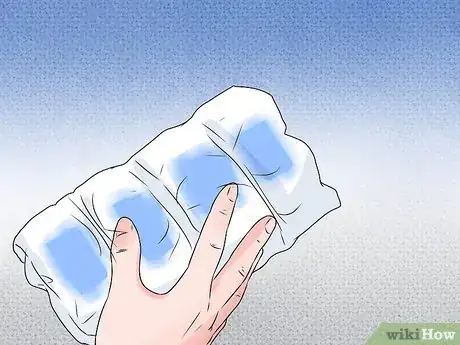

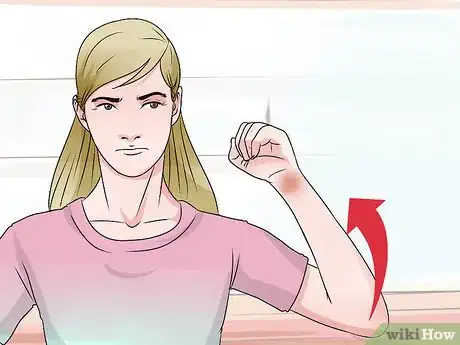
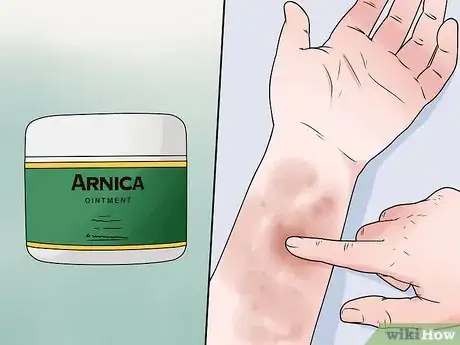

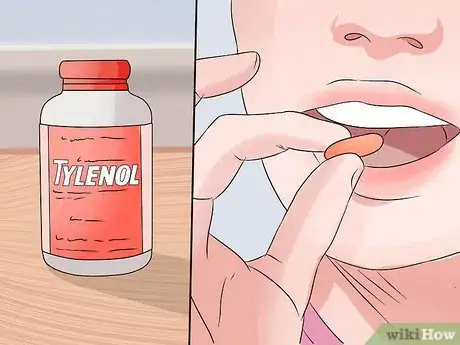
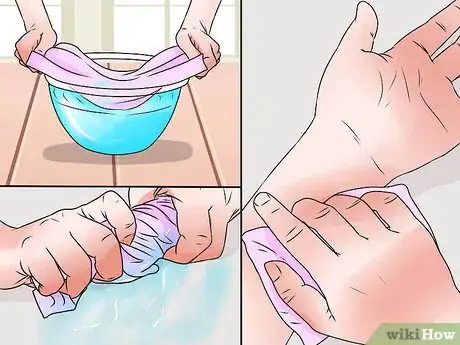
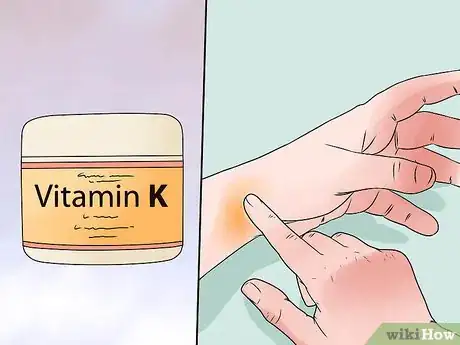
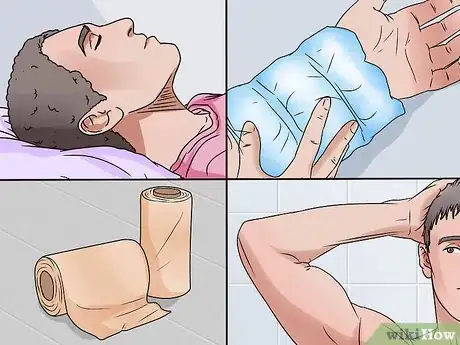
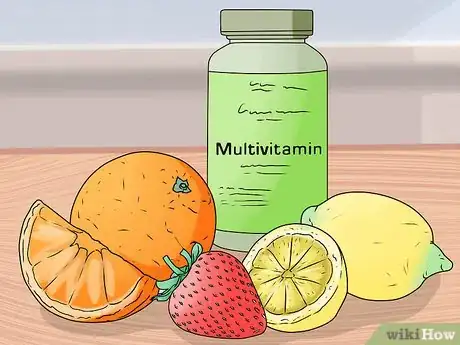

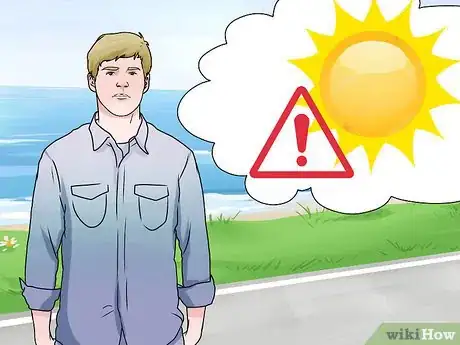
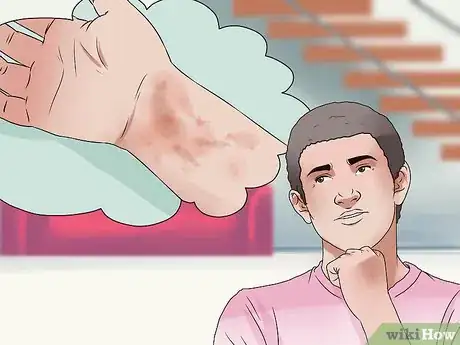
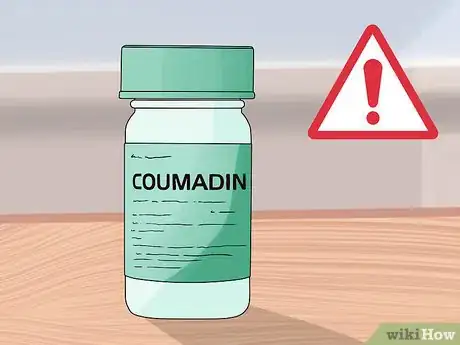
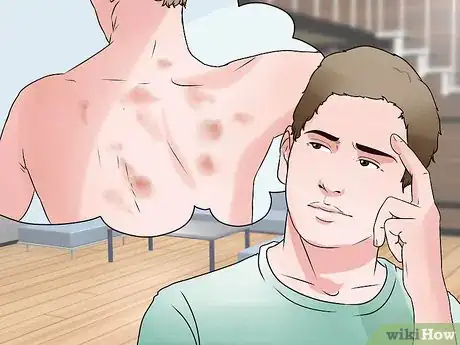
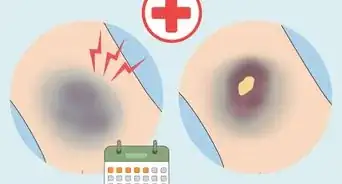
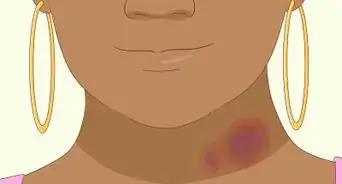
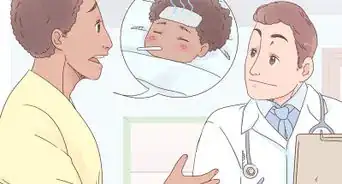
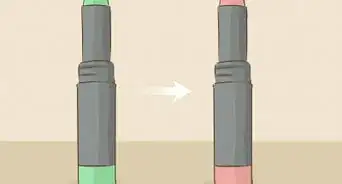

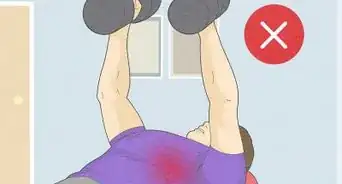

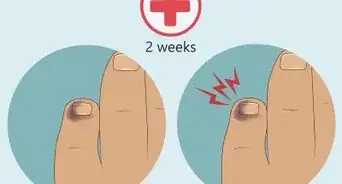

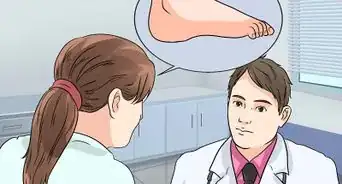
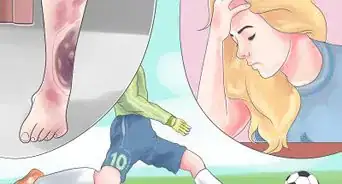
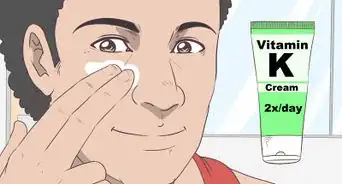
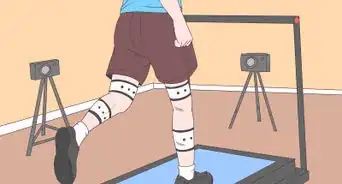
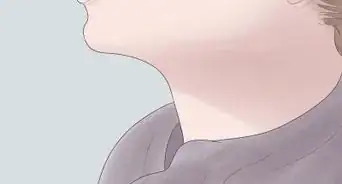








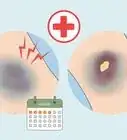
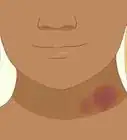
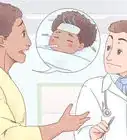




































Medical Disclaimer
The content of this article is not intended to be a substitute for professional medical advice, examination, diagnosis, or treatment. You should always contact your doctor or other qualified healthcare professional before starting, changing, or stopping any kind of health treatment.
Read More...